Rooms 22-28
The new staircase next to the Cappella dei Priori leads down to these largely undistinguished rooms on the middle floor of the palace.
Room 22
Tezi Altarpiece (1500)
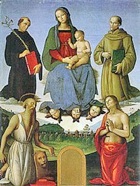
The altarpiece was specified as the exemplar for an altarpiece that Bartolomeo di Lorenzo commissioned from Eusebio di San Giorgio for Sant’ Agostino in 1506. Perugino’s altarpiece remained in its original location until 1653, when it was moved and subsequently dismembered.
-
✴The main panel, which depicts the Madonna and Child with SS Nicholas of Tolentino and Bernardino, remained in the church until 1863, when it was transferred to the gallery.
-
✴The predella, which depicts the Last Supper, seems to have been a workshop production. It was probably stolen during the French occupation of Perugia in 1797. It turned up in a private collection in Frankfurt in 1833, when it was sold to the Staatliche Museen, Berlin. It is illustrated in this page from Wikipedia.
Gonfalon of the Madonna della Giustizia (1496)
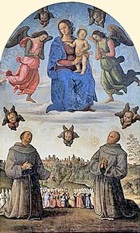
The usual name given to the work derives from the fact that it was, for a period, confused with a second banner (now lost) that the Confraternita di Sant’ Andrea (which was also known as the Confraternita della Giustizia) commissioned in 1501.
The banner depicts the Madonna and Child on a cloud with angels, with SS Francis and Bernardino kneeling in a meadow below. St Francis commends to the Virgin a group that includes the priors and their families as well as members of the confraternity. The road behind them leads to Porta Eburnea and the buildings of Colle Landone that were subsequently demolished.
Gonfalon della Consolazione (ca. 1496-8)

When the confraternity was suppressed in 1797, one of its members hid the banner in his home in order to avoid confiscation by the French. The confraternity re-opened and merged with the Confraternita di San Pietro Martire in 1801, and the banner was moved to the Oratorio di San Pietro Martire. It entered the gallery in 1863.
The banner, which has been recently restored, depicts the Madonna and Child seated in a rural landscape and flanked by a pair of praying angels, with members of the confraternity kneeling to the sides.
Ranieri Annunciation (ca. 1496)
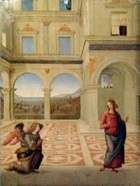
Room 23
Monteripido Altarpiece (1502)
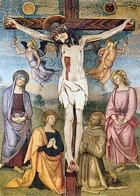

In 1502, the friars of the Convento di Monteripido used money that had been left to them in a will some five decades earlier to commission this double-sided altarpiece from Perugino. It probably replaced another double-sided altarpiece (early 14th century) of similar width that was subsequently recorded in the Convento di Sant’ Antonio di Padova, Paciano Vecchio, outside Perugia (now in the Galleria Nazionale - Room 4).
-
✴On the side facing the friars in the choir, mourning figures of the Virgin, SS Mary Magdalene, John the Evangelist and Francis and angels were painted to form the backdrop to the polychrome wooden Crucifix (ca. 1460) attributed to Giovanni Tedesco that already decorated the high altar.
-
✴On the side facing the congregation, the Apostles witness the Coronation of the Virgin, which takes place in a mandorla supported by angels. (The friars specified the enthroned Christ and the Virgin with four saints below: the final composition reflected that of the Coronation of the Virgin (1486) that Domenico Ghirlandaio had painted for the high altar of the church of another Observant Franciscan convent, San Girolamo, Narni.
-
✴There was also a predella, subsequently lost, that included representations of SS Bernardino da Siena and Bernardino da Feltre.
It is sometimes argued that Perugino would have been unable to complete the commission quickly, since he was away from Perugia in late 1502 and for most of 1503. However, Raphael used parts of the composition of the backdrop to the Crucifix for his altarpiece (1503) of the Crucifixion with Saints (Mond Crucifixion) in San Domenico, Città di Castello. This suggests that the Monteripido Altarpiece was at least designed by 1503 and that its execution might have been largely delegated to the workshop.
Agostino Tofanelli selected the altarpiece for the Musei Capitolini, Rome in 1812. It was returned to Perugia in 1817 and ceremonially translated to its original position on the high altar in 1822. It entered the gallery in 1863 and was restored in 1994.
Adoration of the Shepherds (ca. 1504)

The Ercolani family probably commissioned the three frescoes that were recorded in the lunettes in walls of the Cappella della Natività, in the first cloister of the Convento di Monteripido. These frescoes, which were attributed to Perugino, depicted:
-
✴the announcement to the shepherds of the birth of Christ;
-
✴the Adoration of the Shepherds (above the altar); and
-
✴the Adoration of the Magi.
The frescoes were recorded in 1674, by which time they were badly damaged. Those on the side walls were subsequently lost. The fresco of the Adoration of the Shepherds was detached in 1856. It was restored as far as possible in 1994.
In this fresco, the baby Jesus lies on the ground, adored by the Virgin and St Joseph and four kneeling shepherds. The composition of this surviving fresco is related to two other frescoes of this subject:
-
✴the fresco (1496-1500) in the Collegio del Cambio; and
-
✴the fresco (1503) in San Francesco, Montefalco.
It was probably painted shortly afterwards.
St John the Baptist Altarpiece (ca 1510)
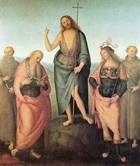
The panel depicts St John the Baptist standing in a landscape, flanked by SS Francis, Jerome, Sebastian and Antony of Padua. The figure of St Sebastian is curiously dressed and has been adapted, somewhat opportunistically, from a cartoon used in Perugino's frescoes (ca. 1500) in the Collegio di Cambio. Two other stylistic considerations provide circumstantial evidence for the dating to ca. 1510:
-
✴The composition, and in particular the figures of SS Francis and Jerome, seem to derive from the Madonna di Loreto (1507), which Perugino painted for Santa Maria dei Servi and which is now in the National Gallery, London.
-
✴Mariano de Ser Austerio used the figure of St John the Baptist in the altar frontal (1512) that he painted for the Cappella di San Giovanni Battista of the Collegio di Cambio.
Madonna della Cucina (ca. 1515)
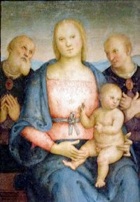
Transfiguration (1517)
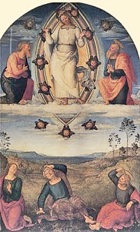
-
✴The main panel is based on the fresco (1496-1500) of the Transfiguration that Perugino had painted in the Collegio del Cambio, with the addition of a rural landscape and a mandorla of seraphim around the transfigured Christ.



-
✴Three small panels that also came from Santa Maria Nuova in 1863, which are separately exhibited in this room, seem to have belonged to the predella of this altarpiece. They depict:
-
•the Annunciation;
-
•the Nativity; and
-
•the Baptism of Christ.
-
It is possible that there were originally one or two others that have been lost.
St Jerome (16th century)
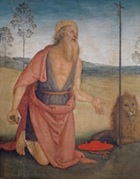
St Jerome is depicted as a hermit, kneeling in contemplation of a Crucifix, with a stone in his hand and his lion and cardinal’s hat on the ground nearby. The figure is set in a rural landscape.
Room 24
Santa Maria dei Fossi Altarpiece (1496)
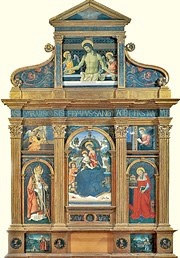
It seems likely that Pintoricchio had been associated with the project for some time, and that he had designed the frame and probably planned the composition. However, a series of codicils to Melchiorre’s will reduced had reduced the sum of money that was available for the commission, and it was only in February 1495 that sufficient funds were in place to support a formal contract. This was agreed between the artist and Prior Girolamo di Francesco da Venezia, who specified the iconography of the altarpiece in some detail. Alfano Alfani administered the funds that were deposited by the canons and paid to Pintoricchio, who was compensated for the rent of a workshop and undertook to complete the work in two years.
This was the most important commission that Pintoricchio ever received in his native Perugia, and it received extraordinary acclaim when it was unveiled. It was influential with other contemporary artists, including the young Raphael. It was still in situ in 1732 but had been dismembered by 1784, when its components were in the choir. The panels escaped the Napoleonic expropriations and were reconstituted in the original frame in 1863.
The canons designed the iconography of the altarpiece in order to tell the story of the incarnation of Christ as a prelude to the redemption of mankind:
-
✴Small panels flanking the upper part of the central panel depict the figures of the Annunciation.
-
✴The central panel depicts the Madonna and Child enthroned with the young St John the Baptist, who hands a reed Cross to the baby Jesus as a sign of His fate. Christ holds a pomegranate, the symbol of redemption. The inscription underneath reads: “O holy child [i.e. St John], give this cross to the Child. You will not carry it to God on behalf of the world; there will be another”.
-
✴The panel in the top register depicts the Pietà, with angels holding the arms of the dead Christ, revealing His wounded hands. The inscription below, which may not be original, translates: “Look, O mortal, by what blood you have been redeemed. Make sure that it has not been shed in vain”.
Two of the doctors of the church are shown in meditation in the main side panels:
-
✴The presence of St Jerome was specified in the will of Melchiorre di Goro. He is dressed as a cardinal, is accompanied by his lion, and carries a model of a centrally-planned church with a portico. This church, which is repeated in the landscape to the left of the Madonna’s throne, does not seem to represent Santa Maria degli Angeli but might represent the Pantheon, Rome.
-
✴St Augustine, the founder of the order to which the canons of Santa Maria degli Angeli belonged, carries an apple as a symbol of redemption.
All of this faithfully reflected the terms of the original contract. However, this was not the case with the predella panels:
-
✴The tondi under the four pilasters contain representations of the Evangelists.
-
✴The predella panel below the figure of St Augustine depicts a scene in which he speaks to a child who is trying to pour the sea, cup by cup, into a hole in the sand. The story goes that, when St Augustine asked her how she could hope to succeed in this immense task, she asked him how he could hope to understand the mystery of Christ’s incarnation.
-
✴The central predella panel, which depicted the baptism of Christ, was replaced at some point by a “mediocre copy” that was in turn lost when the polyptych was dismembered in the 18th century.
-
✴The predella panel below the figure of St Jerome depicts him as a hermit in the dessert, contemplating the Crucifixion.
These scenes, although entirely logical and consistent with the specified iconography for the rest of the altarpiece, bear no resemblance to those specified in the contract:
-
✴the panels under the four pilasters were to represent:
-
•St Ubald (the patron saint of Gubbio, who had imposed the canonical rule in the cathedral there in the 12th century);
-
•St Bernard (probably St Bernard of Rodez since he was to be dressed as a regular canon);
-
•St Joseph; and
-
•a saint whose name is difficult to read but was apparently St Dignamerita;
-
✴the central predella panel was to represent Pope Alexander VI “in majesty” with four cardinals and five canons “at their feet”; and
-
✴each of the other two panels was to represent a cardinal “in majesty”, with a bishop, a canon and a kneeling “convert”.
It is obvious that this part of the commission was largely imposed upon the canons by someone close to Alexander VI. At least two (not mutually exclusive) possible candidates arise:
-
✴Pintoricchio, who had been commissioned to paint the frescoes of the Borgia Apartments of the Vatican Palace in 1492-4 and was documented shortly thereafter as “magister Berarinus pictor palatii apostolici” (effectively as court artist); and
-
✴Alfano Alfani, whom Alexander VI was to appoint as vice-treasurer of the Apostolic Province of Umbria in 1499.
Alexander VI and his young son, then Cardinal Cesare Borgia, must have been duly gratified when they heard about the commission during their 16-day stay in Perugia in June 1495. However, they apparently departed among the curses of the citizens, presumably because of their own behaviour and that of their considerable entourage. This could very well account for the fact that the scheme for the predella was subsequently changed.
Gonfalone di Sant' Agostino (1499)
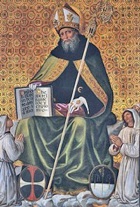
The banner depicts St Augustine enthroned with three kneeling figures of members of the flagellant confraternity.
Frescoes from San Nicolò (1498)
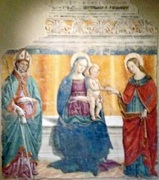
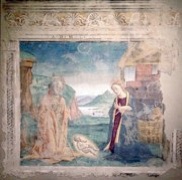
These damaged frescoes, which are dated by inscription and attributed to Fiorenzo di Lorenzo, came from the parish church of San Nicolò, which later became San Giorgio dei Tessitori. They were detached in 1878, just before the church was demolished to make way for the Istituto di Pena Maschile.
The surviving fragments exhibited here depict:
-
✴the mystic marriage of St Catherine, with St Nicholas of Bari; and
-
✴the Nativity, in which the new born baby Jesus lies naked in a meadow in front of the stable, venerated by the kneeling Virgin and St Josep.
Other fragments in the deposit of the gallery depict figures of SS Sebastian, Francis and John the Baptist.
Room 25
Sant' Agostino Polyptych (1502-23)
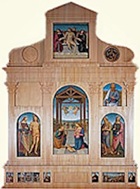
Perugino was commissioned in 1502 to paint some 30 panels for the polyptych. Progress was slow and the friars resorted to litigation, before renewing Perugino’s contract in 1512. They returned to the fray again in 1520, pressing Perugino to complete his work by 1521. It must have been largely complete by the time of his death in 1523 because his executors requested final payment. (As part of this final payment, the friars promised to move Perugino’s body from the Oratorio dell’ Annunziata, Fontignano to Sant’ Agostino, but this promise was never honoured.)
The altarpiece was dismantled in 1654 and its panels were displayed in various locations in the church. They were moved to a store room when the church was restored in 1794. Napoleon's commissioner, Jacques-Pierre Tinet selected seven of them for confiscation in 1797, and they were subsequently dispersed (see below). The remainder were moved to the gallery in 1863.
-
✴The restoration of the panels in the gallery in 1997 allowed their original locations within the frame and the sequence in which they were painted to be established.
-
✴The twelve panels in the double-sided predella were integral to the structure of the frame, and they were probably in place by 1512. Since Perugino had been away from Perugia for most of the period 1502-12, these panels were probably largely the work of his workshop.
-
✴The panels that formed the central register of the side of the altarpiece facing the nave seem to have been installed soon after 1512.
-
✴The panels that formed the central register of the side of the altarpiece facing the friars’ choir seem to have been painted and installed over an extended period that probably culminated in ca. 1520.
-
✴The last substantial panels to be painted seem to have been those of the two upper registers.
The probable reconstruction is illustrated in this page in Wikipedia.
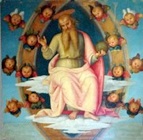
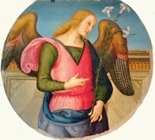
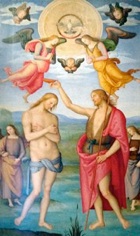
-
✴God the Father (in the top register, exhibited here, illustrated above);
-
✴SS Philip and Augustine (now in the Musée des Augustins, Toulouse), with the Archangel Gabriel (exhibited here, illustrated above);
-
✴the Baptism of Christ (the main panel, exhibited here, illustrated to the right); and
-
✴SS Herculanus and James (now in the Musée des Beaux Arts, Lyon).
A panel of the Virgin Annunciate that was the pendant to the Archangel Gabriel was among those taken to France in 1797, but was subsequently lost.
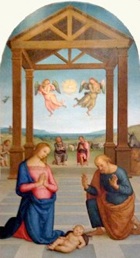
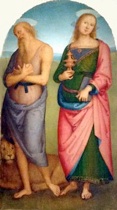
The main panels from the side of the polyptych facing the friars were:
-
✴the Pietà with the Virgin, St John the Evangelist and Joseph of Arimathea (taken to France in 1797 and returned to Perugia in 1816, when it was given to the monks of San Pietro);
-
✴SS Sebastian and Irene (now in the Musée des Beaux Arts, Grenoble), with a young saint (possibly St Martin of Tours) with a sword above (now in the Musée du Louvre, Paris) ;
-
✴the Adoration of the Shepherds (the main panel, exhibited here, illustrated above); and
-
✴SS Mary Magdalene and Jerome (exhibited here, illustrated above), with St Bartholomew above (now in the Museum of Art, Birmingham, Alabama). bly St Martin of Tours) with a sword above (now in the Musée du Louvre, Paris).
The twelve predella panels are now in the gallery, although only two are displayed (in Room 26 - see below).
Room 26
Flagellation of Christ (ca. 1480s)
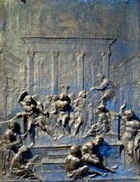
Martini drew on earlier works by Donatello for the technique used for the background, in which the surrounding buildings are “sketched” in shallow relief. The main action occurs in the middle ground, where Christ is whipped before Pontius Pilate. Two other prisoners sit on the steps in the foreground, apprehensively waiting their turn to be whipped, while the Virgin and her women (on the left) and St John the Evangelist (on the right) sorrowfully witness the scene.
Predella Panels from the Sant' Agostino Polyptych (1502-23)
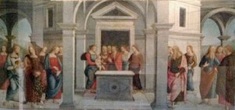
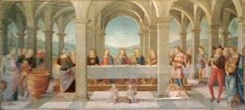
These two (of the original twelve) predella panels from Perugino’s Sant’ Agostino Polyptych depict:
-
✴the presentation of Jesus at the Temple; and
-
✴the wedding at Cana.
The other panels from the polyptych that are in the gallery are in Room 25. See this main entry for more information and links)
Room 27
San Girolamo Altarpiece (ca. 1510)
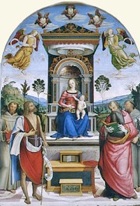
The altarpiece depicts the Madonna and Child enthroned, with two flying angels and the heads of three cherubs above. The scene is set in a landscape, with SS Francis and John the Baptist to the left and SS Jerome and Antony of Padua to the right. The structure of the throne and the figure of St John the Baptist derive from Raphael’s Ansidei Altarpiece (1505), which was then in San Fiorenzo, Perugia.
The document on the steps below the throne contains the clearly written lyrics of a popular Marian hymn, together with the accompanying music, set in four parts.
Predella Panel (ca. 1513)

This recently discovered predella panel, which depicts the Pietà with St Mary Magdalene and a female martyr in tondi, is attributed to Berto di Giovanni. It seems to have belonged to the altarpiece (1513) of SS Antony Abbot, Francis and Bernardino of Siena that was commissioned from Eusebio da San Giorgio for San Francesco al Prato according to the will of Carlo Berardelli. This altarpiece is now in the deposit of the gallery.
St John the Evangelist Altarpiece (ca. 1518)

The panels depict:
-
✴God the Father (in the lunette)
-
✴St John the Evangelist writing his gospel on the island of Patmos (in the main panel); and
-
✴scenes from the life of St John the Evangelist (in the predella).
Madonna del Libro (ca. 1510)
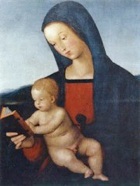
Adoration of the Magi (1505)
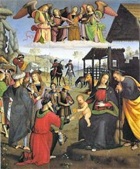
Vasari's attribution of the panel to Eusebio da San Giorgio is generally accepted, although it is sometimes thought to have also involved at least one collaborator. (Eusebio repeated this composition in a documented altarpiece in San Pietro in 1509).
Copy (1609) of Raphael’s Baglioni Deposition
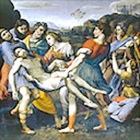
The main panel (which was the only one described by Vasari) depicts the transfer of the body of Christ to the sepulchre. The Franciscans somewhat controversially sold it to Cardinal Scipione Borghese in 1608. (The French took it from Rome to Paris in 1797, but it was subsequently returned to the Galleria Borghese). Cardinal Borghese promised to send a copy to Perugia, and made a payment to Giovanni Lanfranco for the work. However, the copy that he actually sent to Perugia in 1609 (along with five silver lamps by way of additional compensation) is attributed to Giuseppe Cesari, il Cavalier d’ Arpino.
The copy was recorded:
-
✴near the Cappella dei Baldeschi, San Francesco al Prato in 1671:
-
✴above the high altar of the Oratorio di San Bernardino (in the original frame or perhaps a replica of it, with the upper panel of God the Father described below and copies of the original predella panels) in 1683;
-
✴above a door in the chapel in San Francesco al Prato that had originally housed the original in 1784 and 1787.
Although it was listed among works to be sent to the Musei Capitolini, Rome in 1812, it was subsequently decided that it should remain in the church. It entered the gallery in 1863.
God the Father (copy, ca. 1608 ??)
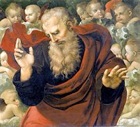
The putative upper panel was documented in various locations after the dismemberment of the altarpiece in 1608:
-
✴Giovanni Francesco Morelli saw it above the high altar of the Oratorio di San Bernardino in 1683. It was in a reconstruction of the original work that also included a copy (1609) of the main panel that is attributed to Giuseppe Cesari, il Cavalier d’ Arpino. He described this upper panel as a copy by Stefano Amadei.
-
✴Giuseppe Maria Modestini saw it above another altarpiece on the Altare del Presepio of San Francesco al Prato in 1787. He believed that it came from the original altarpiece by Raphael.
There is still no consensus on the status of the panel in the gallery. If it is indeed a copy, the location of the original is unknown. Scholars who deem it to be original concede that it is a workshop painting that follows Raphael’s design. (One such design, which is attributed to Raphael) survives in the Palais des Beaux Arts, Lille). Umberto Gnoli attributed it to Domenico Alfani (referenced in the page on this artist). However, the gallery notes support the theory that it is a copy by Stefano Amadei.
Scenes from the life of the Virgin (1525)




As described in more detail in the page on that Raphael , the nuns of Santa Maria di Monteluce signed a contract in 1505 with Raphael and Berto di Giovanni a new altarpiece for the high altar of their outer (public) church. It seems that Berto’s role would relate to:
-
✴the co-ordination of the project as a whole; and
-
✴the painting of the subsidiary panels in Perugia.
The nuns sent Berto di Giovanni to Rome in 1516, presumably to press Raphael to begin work, and the contract was duly renegotiated. It now made a specific division between the work expected of the two artists:
-
✴Raphael would paint the main panel in Rome; and
-
✴Berto di Giovanni would paint, in Perugia, the frame and three predella panels, which would depict:
-
•the birth of the Virgin;
-
•the marriage of the Virgin; and
-
•the death of the Virgin.
Berto di Giovanni subsequently agreed to add a fourth predella panel, depicting the Presentation of the Virgin, as well of panels of SS Francis and Clare for the pilasters of the frame. He provided a carpenter in 1518 to make the frame of the altarpiece and a "cassa” (probably a cover that protected it when it was not in use). However, the altarpiece had yet to be started when Raphael died in 1520. Giulio Romano took over Raphael's responsibilities and the altarpiece was finally installed on the high altar in 1525.
This altarpiece was dismantled in 1750, when the original frame was presumably destroyed. The surviving panels were never reunited:
-
✴The main panel was confiscated by the French under the Treaty of Tolentino (1797). Antonio Canova recovered it in 1815, when it was secured for the Pinacoteca Vaticana.
-
✴The other panels were taken to Rome in 1812.
-
•Those depicting SS Francis and Clare were subsequently lost.
-
•The four predella panels were returned to the church in 1817 and moved to the gallery in 1863.
Room 28
Sant' Agnese Altarpiece (1517)
This altarpiece, which is dated by inscription, is attributed to Berto di Giovanni. It was first recorded in 1801, when the nuns of Sant’ Agnese gave its main panel to those of Santa Maria di Monteluce in return for the hospitality given to them after their suppression in 1798.
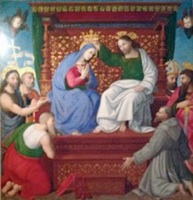
This main panel, which depicts the Coronation of the Virgin with SS Peter, John the Baptist and Jerome on the left and SS Francis, Paul and Herculanus on the right, is based on a drawing by Raphael that is now in the Ashmolean Museum, Oxford. After its transfer to Santa Maria di Monteluce, it was installed on the high altar, where it replaced the panel on the same subject that had been confiscated in 1797. It was listed among works to be sent to the Musei Capitolini, Rome in 1812, but it was subsequently decided that it should remain in the church. It was moved to the gallery in 1863.
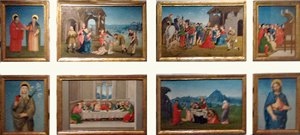
The smaller panels from the altarpiece remained in Sant’ Agnese, although some were moved to the Accademia di Belle Arti in 1810. Eight of them entered the gallery in 1863 and are now displayed together, but separately from the main panel. Their original disposition is unknown, and there might have been others that have been lost:
-
✴Four in the format of vertical rectangles, which probably came from the pilasters of the frame, depict:
-
•SS Cosmas and Damian;
-
•St Bernardino of Siena preaching;
-
•St Clare; and
-
•St Louis of France.
-
✴Four in the format of horizontal rectangles, which probably came from the predella, depict:
-
•the Adoration of the Shepherds;
-
•the Adoration of the Magi;
-
•the Last Supper; and
-
•the Pietà.
Panels from the Santi Quattro Coronati Altarpiece (1506-12)

The “Maestri Lombardi di Pietra e Legname” (the guild of Lombard stone masons and carpenters) commissioned this altarpiece from Giannicola di Paolo for the Cappella dei Lombardi in Santa Maria dei Servi in 1506. It was installed in 1512 and moved to their new chapel in Santa Maria Nuova in 1540.
-
✴The main panel was sent to France in 1810 and it remains in the Musée du Louvre, Paris.
-
✴The predella panels, which remained in Perugia and subsequently passed to the Accademia di Belle Arti and then to gallery. They depict:
-
•SS Herculanus and Constantius;
-
•three scenes from the martyrdom of the “quattro coronati” (four sculptors martyred by the Emperor Diocletian when they refused to sculpt statues of idols); and
-
•SS Bernardino and Sebastian.
Blessed Colomba da Rieti (ca. 1505)
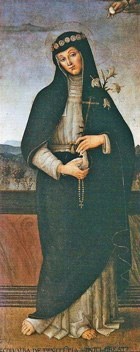
The panel depicts the Blessed Colomba standing on a terrace set in a landscape. She holds a dove, a rosary, a small wooden cross and a lily. The hand of Jesus appears in the top right hand corner, offering her the Host. The inscription along the bottom that identifies her seems to be a later addition.
Pala dell’ Ognissanti (1506-7)
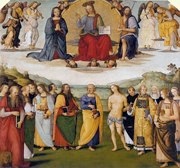
This altarpiece (of All Saints) by Giannicola di Paolo was commissioned for a chapel in San Domenico according to the terms of the will (1493) of Margherita della Corgna, the wife of Baglione di Ugolino dei Montevibiani. Giorgio Vasari recorded it in situ in the 16th century. Although the altarpiece was listed among the works to be sent to the Musei Capitolini, Rome in 1812, it was subsequently decided that it should remain in the church. It entered the Accademia di Belle Arti in 1810 and was subsequently moved to the gallery
In the upper part of the altarpiece, Christ appears in glory in a mandorla between the Virgin and St John the Baptist, with pairs of musical angels to the sides. A number of saints witness the scene from below: those that can be identified include SS Jerome, Nicholas of Bari, John the Evangelist, Paul, Peter, Sebastian, Peter Martyr, Stephen, Catherine of Siena and Mary Magdalene.
Panels from a polyptych (ca. 1510)
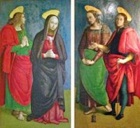
-
✴St John the Evangelist and the Virgin; and
-
✴SS Mary Magdalene and Sebastian.
All the figures are grieving, so they probably flanked a Crucifixion or perhaps a Pietà.
Galleria Nazionale: Sala Podiani and Sala Conferenze Rooms 1-3 Room 4
Rooms 5-6 Rooms 7-10 Rooms 11-16 Room 17 Rooms 18-20 Cappella dei Priori
Rooms 22-28 Rooms 29-32 Rooms 33-40 Deposit
Return to Museums of Perugia.
Return to Walk I.



